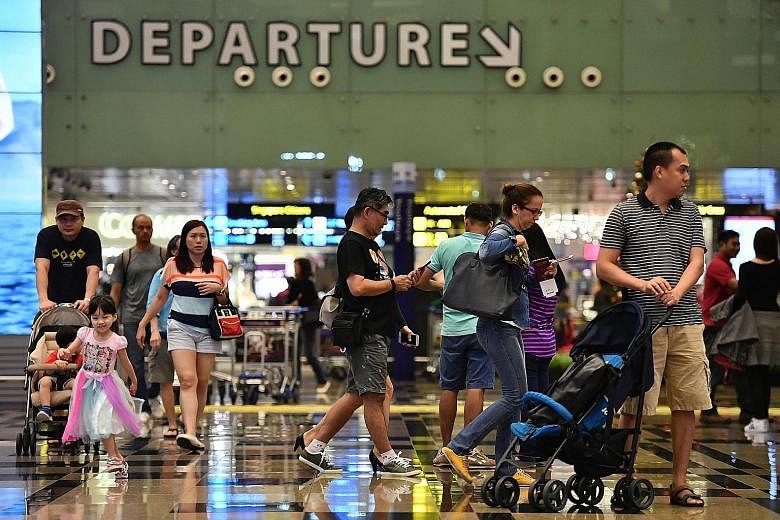Passenger traffic at Changi Airport has climbed to new heights, fuelled in part by a rise in the number of Chinese travellers.
Total traffic last year hit a record 58.7 million, 5.9 per cent higher than in 2015.
From fifth place, China moved to become Changi's third-largest country market - after Indonesia and Malaysia - with a 15 per cent jump in traffic.
The growth trend should persist this year as the Chinese continue to travel in droves, with Singapore among their top destinations, analysts said.
Mr Todd Arthur, vice-president of sales and market development for Sabre Travel Network Asia-Pacific, said that access to cheaper flights and more affordable travel options, along with a rising middle-class population, will fuel Chinese outbound travel.
-
5.9
-
Percentage increase in Changi Airport's total traffic last year, compared with 2015
"At the start of the millennium, Chinese travellers made around 10 million international trips; in 15 years, this figure has increased tenfold to nearly 130 million trips per year," he said.
This bodes well for Changi Airport, even as global economic sentiments are dampened this year, analysts said.
Last year, routes to South-east Asia, North-east Asia and Oceania accounted for 90 per cent of the growth in Changi's passenger traffic, said the airport, which unveiled its annual tally yesterday.
The number of aircraft landings and take-offs increased by 4.1 per cent to 360,490, while total cargo volumes grew by 6.3 per cent to reach a new high of 1.97 million tonnes.
Asian full-service airlines are also growing, said the Association of Asia Pacific Airlines, which represents 16 airlines, including Singapore Airlines.
Last year, member airlines carried 6 per cent more passengers than they did in 2015.
Director-general Andrew Herdman said last week that this was "notwithstanding some unexpected geopolitical developments and macroeconomic uncertainty".
He said: "Asian regional travel markets were relatively strong, as was demand on routes to and from North America, although routes from Asia to Europe saw some weakness following terrorist-related incidents."
Looking ahead, the demand for intra-Asian travel and for flights between Asia and other continents is expected to remain strong in the coming years, said industry bodies such as the International Air Transport Association.
Changi Airport Group's chief executive officer Lee Seow Hiang said: "Despite a backdrop of economic and socio-political uncertainties, we maintain a positive outlook for the year ahead.
"We see opportunities in emerging markets within Africa and Eastern Europe. At the same time, we will continue to grow our long-haul routes to Western Europe, and strengthen our connectivity within the region to secondary cities in South-east Asia, China and India."
Mr Herdman said: "The outlook for air travel markets in 2017 remains broadly positive, although the earlier boost to demand from falling oil prices is now behind us, and growth rates may moderate."
Air traffic at Changi Airport is expected to grow to an estimated 80 million passengers a year by 2025, said SkillsFuture Singapore, a statutory board under the Ministry of Education, in a recent tender document.
Together with the Civil Aviation Authority of Singapore, the agency is embarking on a national initiative to chart jobs and skills that are needed to meet the increased volumes.
Karamjit Kaur

